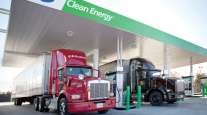Senior Reporter
Experts Urge Preparation Now for Transition to EVs

[Stay on top of transportation news: Get TTNews in your inbox.]
SCOTTSDALE, Ariz. — Sometime in the 2020s or early 2030s a growing number of traditional longhaul trucks could be running on hydrogen fuel cell systems while vans and trucks running regional and local routes — in the 150- to 250-mile per day range or going in and out of ports — will rely on battery-electric propulsion systems.
Those are the main conclusions from a panel discussion at American Trucking Association’s recent Mid-Year Management Conference.
But how trucking gets to that point, experts say, should begin now with research to understand what could be coming.
“You need to start to have a plan now, what you’re doing with the economics of it and you need to do; get in touch with your electric utility early,” Chris Trajkovski of Nikola Motor Co. told the audience of several hundred. “If you’re putting your mini-generation station together now at your yard, and looking at fast chargers — just like with everything in the supply chain, transformers just aren’t sitting around.”
As groups such as the Technology and Maintenance Council advise on types of fast-charging ports that will be available, private sector leaders say they are designing different electric infrastructure systems for specific needs such as high voltage, direct current, 440 volt, fast-charging ports that will allow trucks to stay on the road for longer periods between charges.
But one panelist said part of the challenge in moving toward electrification has to do with the type of charging system your company may select, and how long the trucks need to be on the road in a 24-hour period.
“This is a puzzle that you are having to start putting together,” Nathalie Young with Miami-based Blink Charging, said. “What type of vehicle you pick, what type of charging system that you need? You will have to determine how fast do I need to put these vehicles back on the road?”

Young
Then there are the inevitable supply chain problems that are cropping up.
Young also said alternating current charging ports are readily available. But if your company decides to use direct current charges, it may take up to three months to get those delivered, once they are ordered.
Another panelist, Beneficial Electrification and Electric Vehicle Charging Project Manager Billy Vaughan, of Phoenix, said his company provides rebates for environmentally friendly electric technologies including light-, medium- and heavy-duty electric vehicles. He says it will take years of work to make the transition but fleets are beginning to see the long-term advantages of electric vehicles, especially as the cost of diesel increases. Still, he believes the transition will be an educational one for people in the trucking industry.
“You have to get down to the level of the operators, and the technicians and every element of how quickly and how understanding they are going to be of the technology,” Vaughan told the audience. “We can‘t afford to just come in, roll out the trucks, throw down the keys on the table and say, ‘have a nice day,’ that’s just where our job is beginning.”
Retired UPS Inc. executive Mike Britt, who designed fueling facilities for the Atlanta-based company around the world and who now runs his own Florida engineering and consulting company, said he believes drayage operators will be among the first to see the benefits of electrification to reduce emissions at ports and other urban facilities where air quality issues are paramount.
“It’s all location dependent. I think we’ll see more public charging facilities at the ports,” Britt said. “The trucks are in queue for hours and hours and if you get a system there it would be perfect for them. They don’t do a lot of miles, a couple hundred of miles a day.”

Vaughan
Nikola’s Trajkovski agreed. “The ports are a unique business,” he said. “There are ports across the country that run into the same gridlock and the same delays and dwell time in the queues and it’s knowing what that outlook is about that information and tailoring it for the customer.”
Vaughan said even as the enthusiasm for electric vehicles is increasing, it’s important for management to realize that in some cases it might not be a viable alternative right now and the best course of action is to stay with a diesel-fueled vehicle.
“There isn’t necessarily a solution or vehicle that is going to work on every scenario or every equation. They may have a really complicated route or a complicated customer, and we have to look each other in the eye and say ‘we have to pass on this one and ‘let’s look at the rest of your route structure and other ways you can be successful,’” Vaughan said.
Want more news? Listen to today's daily briefing below or go here for more info:




